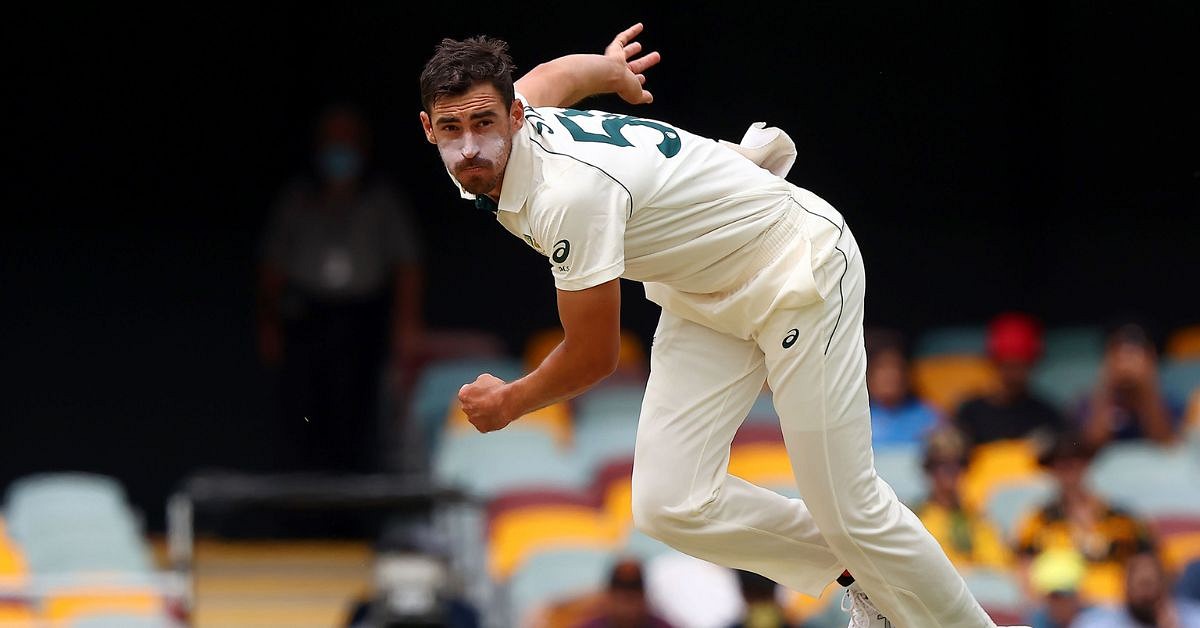


During the third Test of the 2024/25 Border-Gavaskar Trophy, the ongoing rain became too much for Australian pacer Mitchell Starc to handle. With the dominant Aussies looking to wrap up the match, Starc was seen visibly frustrated as the ground staff had to bring out the covers yet again. Fans took to X (formerly Twitter) to express their reactions, with some noting how Starc's reaction was relatable to every fan watching the match. However, others pointed out the advantage that the interruptions may be giving to the bowlers over the batters.
Mitchell Starc's Frustration Over Rain Delay Reflects Fans' Dismay
During the third Test of the ongoing 2024/25 Border-Gavaskar Trophy, Australia's leading pacer Mitchell Starc displayed visible frustration as heavy rainfall forced the ground staff to cover the pitch once again. With the Aussies in a commanding position and looking to secure a victory, the rain interruptions proved to be a major hindrance.
Starc's reaction resonated with many cricket fans, who took to social media to express their disappointment over the weather delays. Some highlighted the relatable nature of his frustration, while others acknowledged the potential advantage they might provide to bowlers over batters.
Background:
Rain delays have long been a part of cricket, with the unpredictable nature of weather conditions often leading to stoppages in play. In recent years, however, the frequency and duration of these delays have become increasingly common, raising concerns among fans and players.
The 2024/25 Border-Gavaskar Trophy has been particularly affected by rain, with several matches experiencing significant interruptions. This has led to calls for improved infrastructure and contingency plans to minimize the impact of weather conditions on the game.
Top 5 FAQs:
1. Why was Mitchell Starc frustrated?
Starc was frustrated because the rain delays were hindering Australia's progress in the match. The Aussies were in a commanding position and were looking to wrap up the game, but the interruptions gave India a chance to recover.
2. How did fans react to Starc's frustration?
Fans took to social media to express a variety of reactions. Some sympathized with Starc's frustration, while others pointed out the potential advantage it could give to bowlers over batters.
3. What is the impact of rain delays on cricket?
Rain delays can have a significant impact on cricket matches. They can disrupt the momentum of the game, give one team an advantage over the other, and even lead to the abandonment of the match.
4. What can be done to minimize the impact of rain delays?
Several measures can be taken to minimize the impact of rain delays. These include improving drainage systems at cricket grounds, using advanced weather forecasting technology, and having contingency plans in place.
5. What is the future of rain delays in cricket?
The future of rain delays in cricket is uncertain. Climate change and the increasing frequency of extreme weather events could lead to more frequent and prolonged delays. However, advances in technology and infrastructure may help to mitigate this impact.

Indian Cricket Team vice-captain Shreyas Iyer proved to be the star of the third ODI against the Australian Cricket Team, not only with his batting skills but also with his incredible fielding. During a crucial stage in the match, Iyer sprinted backwards and dove to catch a difficult ball, resulting in the dismissal of a key Australian batsman. However, he unfortunately injured himself in the process and had to leave the field. This moment of brilliance from Iyer was one of the highlights of the match, leaving fans and experts in awe of his talent and determination.

In the final game of the series, Australia's top six batsmen failed to convert their starts as India bowled them out for just 236 runs. Despite a strong opening stand from Travis Head and Mitchell Marsh and a half-century from Matt Renshaw, India's bowlers, led by Harshit Rana, put up a sensational performance to keep their hopes of avoiding a series whitewash alive. With a target of 237, India will need to bat well to secure a win and gain some momentum before the T20Is.

Despite a solid fifty from Australian opener Matt Renshaw, the Indian bowlers led by captain Harshit Rana were able to restrict the hosts to 236 in their final One-Day International at the Sydney Cricket Ground. Rana's pace and bounce on a fresh pitch, along with tidy bowling from the Indian spinners, proved to be too much for the Aussies. Despite partnerships from Travis Head and Mitchell Marsh, the Australians were unable to set a bigger total for their opponents.

As Harshit Rana's selection in the Indian cricket team for the ongoing tour of Australia sparks debate, we compare his bowling stats after seven one-day matches with that of fellow young pacer Prasidh Krishna's. While Rana has shown promise with an economy rate of 6.06 and 12 wickets, Krishna's 4.84 and 18 wickets in the same number of matches suggest he might have the edge. However, Rana's best figures of 3-31 against Bangladesh and his overall consistent performance cannot be overlooked. Will he outshine Krishna and silence the critics in the upcoming Sydney ODI?

In an intense clash between India and Australia in the third ODI, star batter Shreyas Iyer made an exceptional catch to dismiss Alex Carey but appeared to injure himself in the process. With Australia dominating the series with back-to-back wins, the Men in Blue are fighting to avoid a clean sweep. Despite a strong start to the third ODI, Iyer's injury casts uncertainty on his return to the field and with the bat.

Former Indian captain Kris Srikkanth criticized young pacer Harshit Rana's selection in the Indian squad but also praised his batting performance in the second ODI against Australia. Srikkanth believes Rana could have been the Player of the Match if India had won the game. However, he highlighted Rana's short bowling spell as a weakness, despite picking up two important wickets. He also commended Rana's highest score for India in his 12th international outing and his contribution to the team's competitive total of 264.

Indian left-arm pacer Arshdeep Singh successfully dismissed Australian captain Mitchell Marsh for just 11 runs in the second ODI in Adelaide on October 23. With this wicket, he also gave India their first breakthrough and ended the 30-run opening partnership for the Aussies. Although Marsh had played a crucial role in their victory in the first ODI, India was able to restrict Australia to 264/9 with the help of notable performances from Rohit Sharma, Shreyas Iyer, Axar Patel, Harshit Rana, and Singh. The Aussies are currently 34/1 after 9.3 overs and India must win the game to keep their hopes alive in the series.

With Australia already leading 2-0 in the series, India will be looking to avoid a whitewash when they face Australia in the third ODI in Sydney. The dominance of Australia's top order, led by Mitchell Marsh and Matt Short, has been a key factor in their success so far. Meanwhile, India will be hoping for a strong performance from their middle order, after struggling to find rhythm in the first two matches. Captain Virat Kohli and young talent Shubman Gill will need to step up for India to have a chance at a win.

In a disappointing match for West Ham fans, new manager Nuno Espirito Santo's search for his first win continued as the team suffered a 2-0 defeat against Leeds. Aaronson opened the scoring early on, followed by Rodon's goal from a corner. The Hammers are now second bottom in the league, with only one win in their last eight matches. Fans and commentators alike are feeling sorry for the struggling team, with some showing empathy towards their supporters.

In a disappointing performance, India failed to defend their total in the second ODI against Australia, ultimately losing the series 2-0. Captain Shubman Gill acknowledged that drops catches and an insufficient total were key factors in their defeat. Despite praise for Rohit Sharma's resilient knock, India's fielding was not up to par, missing several opportunities to dismiss key batsmen.